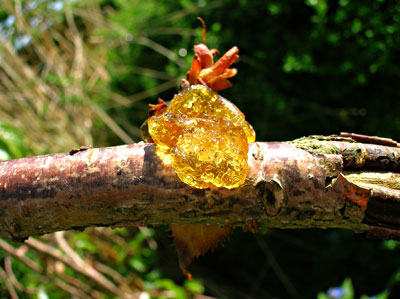 |
| Gummosis on an ornamental cherry. Photo by Roger Griffith, https://en.wikipedia.org/wiki/Cherry_wood |
By C. J. Walke
Most Maine orchards typically grow apples and pears – hardy, long-lived pome fruit that withstand cold Northern winters and the tests of time. However, stone fruits of the genus Prunus (peaches, plums, cherries, nectarines, apricots) are a pleasant addition to the small orchard or backyard planting, blooming earlier in spring than apples and pears, and providing delicious fruit in August while most pome fruit varieties are still ripening on the tree. Peaches are often found at farmers’ markets, but other stone fruits are rare, despite their delight for almost any palate.
So a planting of stone fruit trees can be desirable, but it can also attract insects and diseases that you will not find in your apple or pear blocks. In previous articles (in the June-August 2012 and Sept.-Nov. 2012 MOF&G), I wrote about my struggles with disease in MOFGA’s hybrid plum block (hybrid plums are crosses of American and Asian species), specifically with brown rot and now with what appears to be bacterial canker, a disease that infects bark tissue and produces cankers that weep a “gummy” ooze.
Gummosis
Gummosis is a broad term commonly used to describe the oozing of sap from wounds on stone fruit trees, caused by mechanical injury, winter injury, environmental stress, disease pressures or any combination of these. The “gum” can range from rather clear to amber, similar to light maple syrup. Mechanical injury often produces a clear gum, while pathogens often result in an amber ooze. Both bacterial canker and brown rot cause gummosis from infected wounds where the disease entered the tree or from cankers caused by the disease.
Treating these diseases can be challenging in the organic orchard, especially if you prefer to avoid mineral fungicides and want to focus on cultural methods, as I do in MOFGA’s orchards. Sulfur-based fungicides can be used to combat brown rot during bloom to prevent the blossom blight phase of the disease and again for two to three weeks before harvest to protect the fruit. (Pay attention to label instructions and days to harvest intervals.) Although copper is a common bactericide, it is rather ineffective against bacterial canker, so cultural methods are strongly encouraged, including proper pruning to maintain good air flow; destroying all drops and mummies; removing from the area wild Prunus species that may harbor disease; and pruning out and burning diseased wood and cankers.
The Final Cut
As I wrote in previous articles, I first noticed significant brown rot in MOFGA’s hybrid and European plum block in late July of 2011, when the hybrid plums, just a few weeks from harvest, were rapidly succumbing to powdery tan masses of fungal spores. I focused on the cultural method of gathering all drops and even picking infected fruit from the tree at the earliest sign of infection. In hindsight, this early picking may have opened the tree to further infection by breaking the fruit off the cluster and exposing the tree’s vascular system, but that also seemed to be occurring when the infected fruit eventually fell on its own.
In March of 2012, I pruned out all the cankers and infected wood I could find, whether from brown rot or bacterial canker, disinfecting tools with a 10 percent bleach spray between every cut, which was very time consuming. I actually set up a series of hooks along a branch of the tree and, working with three folding saws and two hand-pruners, allowed the disinfected tools to dry on the hook while making the next pruning cut. (This may have been overkill, but I didn’t want to risk spreading disease.) All this wood was kept separate from the other prunings and promptly burned at the edge of the orchard.
During bloom, I noticed numerous sites along one- to two-year-old wood with gummosis. I was not sure if it was coming from existing small cankers that I had missed or from new infection sites. Most infected trees had a few signs on different limbs, but this was drastically worse on the two largest trees, ‘La Crescent’ and ‘Toka’, where every pencil-sized limb seemed to have numerous cankers. As a desperate attempt, I cut off a few main scaffold branches on these two trees and grafted on wood from other orchards to rebuild the shape of the tree.
For the next couple of months, things seemed to be under control, the grafts all took and were shooting to the sky, and I thought that I had averted a crisis creatively. By July, I was proven wrong. More cankers had appeared on pencil-sized twigs, and at the base of nearly every scion I grafted onto the tree, an enormous amount of amber gum was oozing and dripping down the tree. I did more pruning and burning in the dry weather of late July and early August, but I think my efforts were in vain.
So this year, in early March when I dust off the pruning tools, I am sad to say that the chainsaw will be with me, and two trees will receive that roaring, heart-wrenching final cut.
C.J. Walke is MOFGA’s organic orchardist and librarian. You can address your orcharding questions to him at 568-4142 or [email protected].
